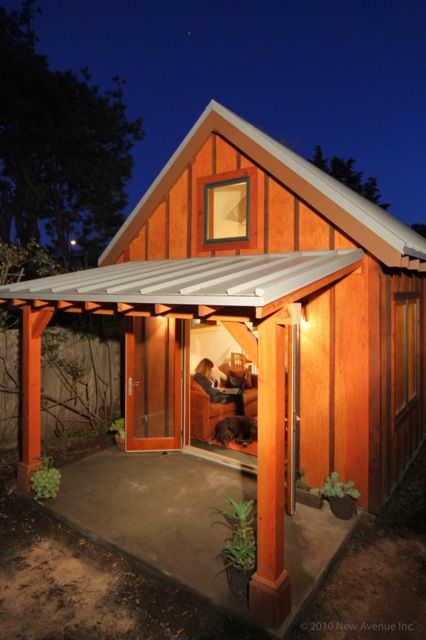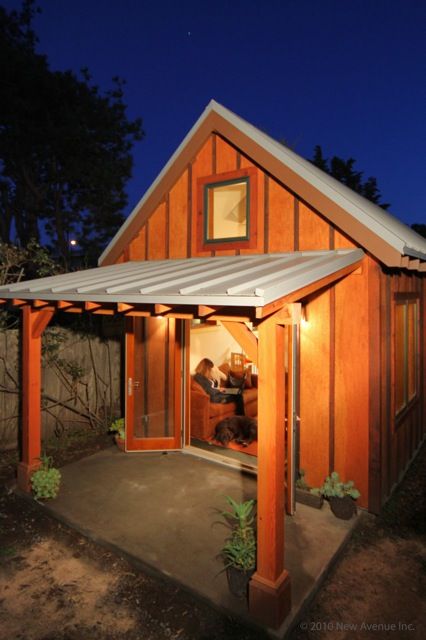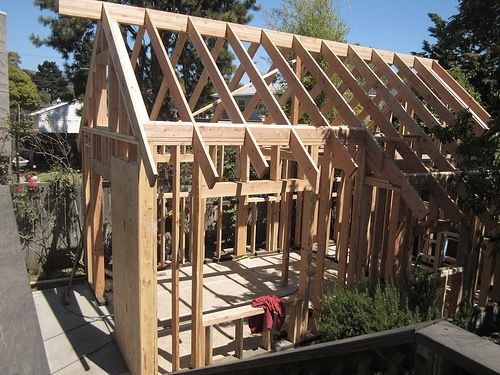Could There Be a Boom of Backyard In-law Cottages?

In the nearly three years I spent researching and writing a book about accessory dwelling units-In-laws, Outlaws, and Granny Flats: Your guide to turning one house into two homes-I thought I had seen every variation of designing and building ADUs out there. But as I was putting the book to bed, I came upon a developer in Berkeley, Kevin Casey, with a new twist. Namely, Casey’s start-up offers homeowners a turn-key ADU package that includes private financing, design, permit approval and construction. What’s more, he seems to be making a go of it, with a first backyard cottage garnering a lot of praise, and six more units in the pipeline. Now he’s looking for builders in other regions to partner with.
Whether Casey’s ADU model will thrive in other states depends on its surmounting some formidable barriers-particularly, zoning codes. But it should do well in Left Coast cities and suburbs from San Diego to Seattle, which are by and large receptive to second units. And it’s hard to argue with his numbers. To keep this blog brief, I will encapsulate four Q&A’s below and let the interview do the rest of the talking.
Q: Why the interest in second units these days?
A: Bunch of factors. Households are much more diverse, with many more multi-generational set-ups. We’re no longer a nation of Dad, Mom and 2.3 kids. The Baby Boomers need more flexible housing as they care for aging parents or look ahead to a time when they’ll need care. And despite a population increase of 3.4 million people between 2005 and 2008, we’ve lost 1.2 million households. Clearly, a lot of families are doubling up.
Q: You’re a recent graduate of UC’s Haas School of Business. How did you come to create a start-up that focuses on a building industry niche that’s usually ignored?
A: Well, I took a lot of kidding about it-“What, you need an MBA to build backyard sheds?”-that sort of thing. But the concept grew out of some fairly rigorous analytical research in UC’s engineering, planning and business grad schools. We looked at the ten fastest-growing cities in California, for example, and saw that in the Bay Area, 85% of families can’t afford a median-priced home. So there was a tremendous pent-up demand, under-utilized homes on good-sized lots…and then California passed sweeping legislation in 2003 [Assembly Bill 1866] which gave homeowners the right to build second units. So at that point we said, ‘Wow, here’s a chance to build housing that’s affordable, sustainable, and repeatable in cities across the state.’ Now we’re seeing momentum in other states, too.
Q: Lending homeowners the money to create a second unit on their property is a striking departure from business as usual. You forego banks altogether?
A: Yes.
Q: Sounds like a tough sell to investors.
A: Not at all. Again, this was preceded by a lot of number-crunching; it’s a very attractive proposition. The homeowner owns the lot, so that brings the cost of creating a second home way down. We have models for as low as $60,000 but let’s say, for sake of argument, that it costs $100,000 to create a one- or two-bedroom ADU. In the Bay Area, you can get $1500 to $2000 rent per month for such a dwelling, which works out to $18,000 to $24,000 a year.
So if an investor gets, say, 8% return on his investment, that’s very respectable and it’s a safe investment because it’s secured by a valuable home in a nice neighborhood. It’s also a good deal for a homeowner who, quite often, is an older person with a lot of equity but who might have a hard time getting a loan from a bank to build an ADU, especially if they’re retired and have a relatively low, fixed income. We can configure the financing in many ways, but typically a profit-share goes to the homeowner right from the get-go.
But this isn’t just about the money. Many older homeowners rent the unit to family or friends and they like to have the company around. To be sure, our investors are drawn by the prospect of a healthy ROI, but many of them buy into the “impact investment” philosophy and so feel good about the positive social aspects of our in-law units: more affordable housing, urban infill and LEEDS certified buildings.
Create Your Own In-Law!
If you’re interested in second units, please check out my recent book, Outlaws and Granny Flats: Your Guide to Turning One House into Two Homes. The Library Journal named it one of the 10 Best Design Books for 2011. You can also preview In-laws, Outlaws‘ lush professional photos at www.cozydigz.com
If you will be renovating your home (or perhaps creating an in-law suite), there’s no better companion than Renovation 4th Edition, (November, 2012). Its 614 pages, 1,000 photos and 250 detailed illustrations cover home renovation from start to finish and contain lifetimes of practical, field-tested techniques that professional builders shared with me over a 40-year period.
© Michael Litchfield 2012
If you liked this piece, you’ll love the Green Architects’ Lounge podcast at Green Building Advisor.
You may also enjoy GBA’s Building Science Fundamentals series.
Fine Homebuilding Recommended Products
Fine Homebuilding receives a commission for items purchased through links on this site, including Amazon Associates and other affiliate advertising programs.

Homebody: A Guide to Creating Spaces You Never Want to Leave

Get Your House Right: Architectural Elements to Use & Avoid

A House Needs to Breathe...Or Does It?: An Introduction to Building Science





























View Comments
This project really hits the nail on the head so to speak. The key folks that should be encouraged to consider building a granny unit are homeowners who need to downsize or who need to bring in some additional income. These are not going to be builders or developers that have the experience to walk a project through the development process. No matter how user-friendly the local ordinaces are someone still needs to apply for the permit, pull together the design,go through plan check, find the financing and coordinate the construction process. What may seem like a simple four-step project may be daunting enough that people will shy away from it. To have a local company offer a one-stop service for homeowners takes the worry away, guarantees a workable product at the end and maybe even offers some economy of scale once they have a workable pattern and team of workers lined up. Once you have a couple of completed demonstration units completed this kind of project could run itself just by word of mouth.
This is timely info, but for us, we'll go another route. We recently discovered we need to move another state to be near our ailing child. The area we want to move to is limiting second homes to an area of 700 square feet, and there are not too many designs out there that have met our desires and needs efficiently. They're either cute and useless in utilization, or boxy and bland. Luckily, we found 3 designs which will work.
My mother in law will of caourse, be coming with us. She is getting older, but still healthy, we want to be able to check on her. We foresee purchasing a lot in our desired area and building her a nice shelter, with super insulation and efficient windows, a high effiency heating system. I can do all the work except foundation excavation, I have amny years in the trades, and we're looking to spend less than $30,000 for a budget. It will come out of the proceeds of her present paid for house, giving her spending money she currently does not have.
The only obstacle I see is how much difficulty I may have with building inspectors in my new region--are they knowledgeable about strength and water tightness, new building materials and techniques, along with their kknowledge of whatever building codes they may use, or are they idealogues, intent more on strict compliance to codes, no matter what? As I grow older, I run into lots of younger people who have no knowledge of older techniques, and are afraid of techniques or materials they are not familiar with, creating difficulty in the planning and the execution of a plan. I can build a safe, stong, water tight house, but the shape-shifting codes are my challenge. Each code is different from other current codes, and most are not compatible with others. Combine that with the shallow knowledge of construction I have seen in "inspectors" in the past, I could be screaming mad before its done!
Mike,
great subject!
"under-utilized homes on good-sized lots"
It sounds like a great idea and by having everything included, especially financing it makes it a very viable idea.
To beable to come in and say it will cost X$ to to turnkey, the property owner can easily figure out their ROI (if renting)
Without the financing end of it i do not see something like this getting very far.
DS